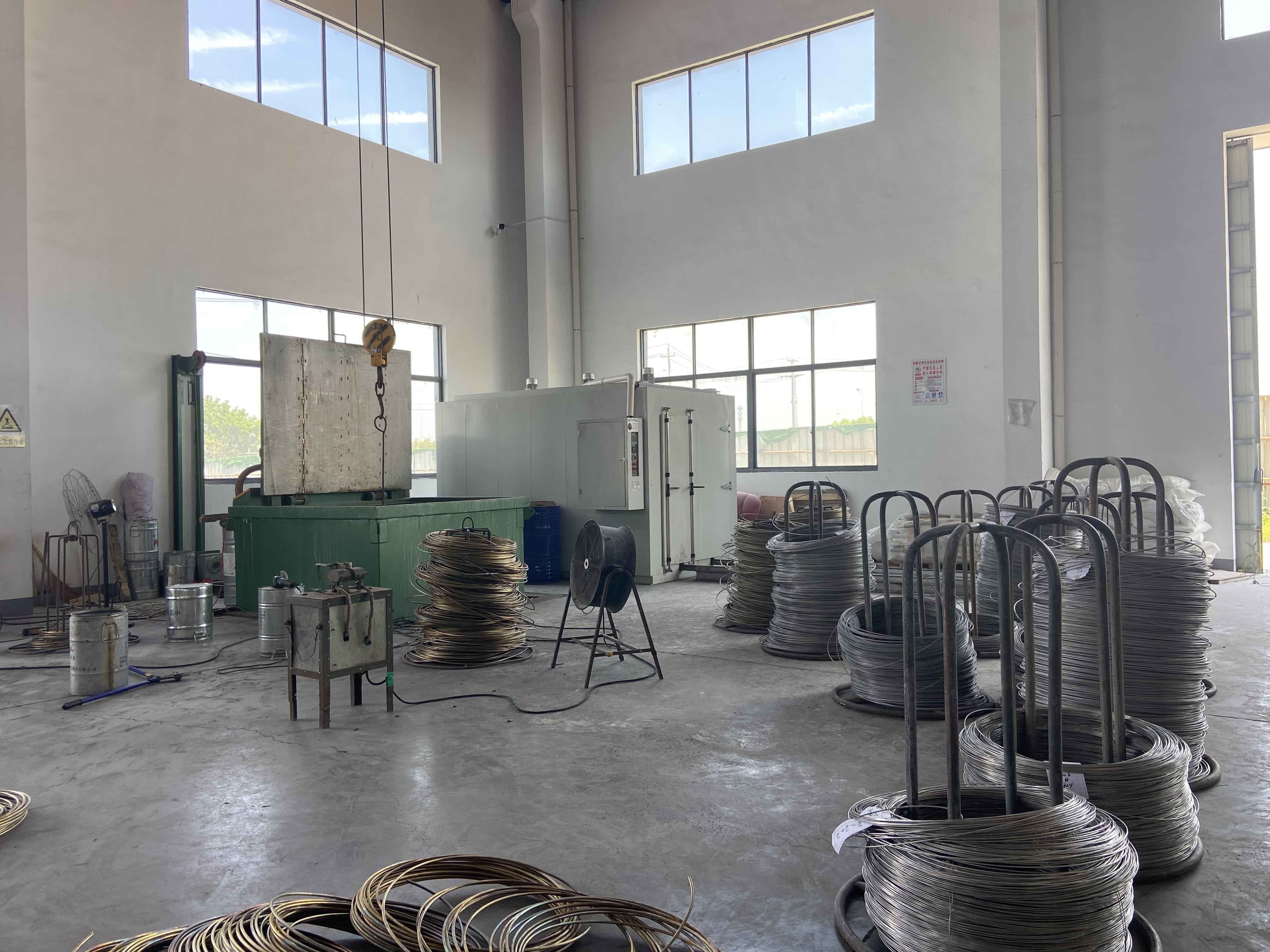NEWS CENTER
Classification and composition comparison of nickel-based alloys
2022-08-10
1. Nickel-based alloy electrodes can be divided into five categories, namely industrial pure Ni, Ni-Cu, Ni-Cr-Fe, Ni-Mo and Ni-Cr-Mo. Each category can be divided into one or more types of electrodes. This type of electrode is mainly used for welding nickel or high-nickel alloys, and sometimes it can also be used for welding or surfacing of dissimilar metals.
2. How to choose nickel-based welding wire
1. ERNiCr-3
For welding 600, 601 and 800 alloys themselves, and welding dissimilar steels between stainless steel and carbon steel ERNiCrFe-7
For welding Inconel alloys within ASTM B163, 166, 167 and 168
2. ERNiCrFe-6 is used for welding of steel and nickel-chromium-iron alloys, welding of steel and stainless steel and nickel-based alloys
3. ERNiCrCoMo-1 is used for welding dissimilar welding of nickel-chromium-cobalt-molybdenum alloys and various superalloys
4.ERNiCrMo-3
It is used for welding of nickel alloy, carbon steel, stainless steel and low alloy steel, mainly used for welding of 625, 601, 802 alloy and welding of 9% nickel alloy
5. ERNi-CI industrial pure nickel, used for welding malleable iron and gray iron
6. ERCuNi is used for welding of 70/30, 80/20, 90/10 copper-nickel alloys
7.ERNiCu-7 is used for welding nickel copper alloys B127, 163, 164 and 165 etc.
8. ERNi-1 is used for welding of pure nickel castings and forgings, such as: alloys within ASTM B160, 161, 162, 163 standards
9.ERNiFeMn-CI is used for welding of nodular cast iron, ductile iron, malleable cast iron and grey cast iron itself or for their welding with stainless steel, carbon steel, low alloy steel and various nickel alloys
10. ERNiCrMo-4 is used for welding of nickel-chromium-molybdenum alloy itself, or welding of nickel-chromium-molybdenum alloy and steel and most other nickel-based alloys
11. ERNiCrMo-11 is used for welding of nickel-chromium-molybdenum alloy itself, or welding of nickel-chromium-molybdenum alloy and steel and most other nickel-based alloys, and can also be used for surfacing welding of nickel-chromium-molybdenum alloy and steel welding seam
12.ERNiCrMo-13 is used for welding low carbon nickel chromium molybdenum alloy
3. Nickel-based electrode
1. ENiCrMo-3 is used for welding nickel-chromium-molybdenum alloys, such as 625, 800, 801, 825 and 600
2. ENiCrFe-3 is used for welding of nickel-chromium-iron alloy itself and welding with carbon steel
3. ENiCrFe-2 is used for dissimilar welding between austenitic steel, ferritic steel and high-nickel alloy, and can also be used for welding of 9% nickel alloy
4. ENiCu-7 is mainly used for dissimilar welding between nickel-copper alloy itself and steel
5. ENiCrFe-7 is used for welding of 690 (UNS N06690) nickel-chromium-iron alloy itself
6. ENiCrMo-4 is used for welding C-276 alloy and most other nickel-based alloys
7. ENiCrCoMo-1 is used for welding nickel-chromium-cobalt-molybdenum alloys and dissimilar welding between various superalloys
8. ERCuNi welded forged or cast 70/30,80/20,90/10 copper-nickel alloy
9. ENiCrMo-13 is used for welding low carbon nickel chromium molybdenum alloy
10.ENiCrMo-11 is used for welding low carbon nickel chromium molybdenum alloy
11. Pure nickel electrodes A5.11 ENi-1 EL-NiTi3 ≥ 92 - - Ti2.5 - welding 200, 201 nickel alloys and nickel-plated steel plates; - welding of steel and nickel dissimilar materials; - surfacing of steel.
12. Nickel copper electrode A5.11 ENiCu-7 EL-NiCu30Mn 65 - - Mn ≤ 4.0 The rest are welding of copper-Monel 400 alloy itself; and welding of Monel 400 alloy and steel; - used for surface surfacing welding of steel .
13. Copper-nickel electrode A5.6 ECuNi S-CuNi30Mn ≥ 29 - - Mn2 The rest is copper - for the welding of copper-nickel alloys and certain bronze materials themselves, and the welding between these materials and Monel 400 alloy or Nickel200.
14. Nickel-chromium electrodes A5.11 ENiCrFe-2 EL-NiCr15FeNb ≥ 62 15 1.5 Mn2.5 Nb1.5 - Welding of creep-resistant joints, welding of dissimilar materials; - of austenitic, ferritic steels and high-nickel alloys Welded, nickel 9%
4. Composition comparison
1. Ni307 Nickel and Nickel Alloy Welding Rod Model GB/T:ENiCrMo-0
Description: Low-hydrogen type Ni70Cr15 heat-resistant and corrosion-resistant alloy electrode, there is an appropriate amount of molybdenum, niobium and other alloy elements in the welding seam, the deposited metal has good crack resistance, and DC reverse connection is adopted.
Uses: It is used for welding nickel-based alloys with heat resistance and corrosion resistance requirements, and can also be used for welding and surfacing of some difficult-to-weld alloys and dissimilar steels.
Chemical composition of deposited metal/%
C≈0.05 Ni≈70 Fe≤7 Nb 3-5 Mo 2-6 Cr≈15
2.Ni307A nickel and nickel alloy electrode Model GB/T:ENiCrFe-3 is equivalent to AWS:ENiCrFe-3
Description: Low hydrogen type Ni70Cr15 heat-resistant alloy welding rod, there is an appropriate amount of manganese, niobium and other alloying elements in the welding seam, the deposited metal has good crack resistance, and DC reverse connection is adopted.
Uses: It is used for welding nickel-based alloys with heat resistance and corrosion resistance requirements, such as Inconel 600, 601, etc., and can also be used for welding and surfacing of some difficult-to-weld alloys and dissimilar steels.
Chemical composition of deposited metal/%
C≤0.1 Mn 5-9.5 Si≤1 Ni 59 Fe≤10 Ti≤1 Nb+Ta 1-2.5
S≤0.015 P≤0.03 Cu≤0.5 Cr 13-17
3.Ni307B nickel and nickel alloy electrode Model GB/T:ENiCrFe-3 is equivalent to AWS:ENiCrFe-3
Description: Low-hydrogen nickel-chromium heat-resistant alloy electrode, there is an appropriate amount of manganese in the weld metal, and DC reverse connection is adopted.
Uses: Used for welding nickel-based alloys with heat and corrosion resistance requirements, such as Inconel 600, 601, etc., and can also be used for welding of dissimilar steels or corrosion-resistant surfacing materials.
Chemical composition of deposited metal/%
C≤0.1 Mn 5-9.5 Si≤1 Ni≥59 Fe≤10 Ti≤1 Nb 1-2.5 S≤0.015
P≤0.03 Cu≤0.5 Cr 13-17
4. Ni317 nickel and nickel alloy electrodes
Description: Low-hydrogen nickel-chromium-molybdenum alloy electrode, with appropriate amount of molybdenum in the weld metal, has good crack resistance.
Uses: Used for welding nickel-based alloys and chromium-nickel austenitic steels, and also for welding dissimilar steels.
Chemical composition of deposited metal/%
C≤0.07 Mn 0.5-1.7 Si≤0.5 Ni 68-78 Nb 0.2-0.8 S≤0.012
P≤0.02 Mo 8.5-11 Cr 13.5-16.5
5.Ni327 nickel and nickel alloy electrode Model GB/T:ENiCrMo-0 is equivalent to AWS:ENiCrMo-0
Description: Low hydrogen type Ni70Cr15 heat-resistant alloy electrode, there is an appropriate amount of molybdenum, niobium and other alloy elements in the weld metal, the deposited metal has good crack resistance, and DC reverse connection is adopted.
Uses: It is used for welding nickel-based alloys with heat resistance and corrosion resistance requirements, and can also be used for welding and surfacing of some difficult-to-weld alloys and dissimilar steels.
Chemical composition of deposited metal/%
C≤0.05 Mn 1-5 Si≤0.75 Ni balance Fe 4-8 Nb+Ta 1.5-5.5 S≤0.015 P≤0.04 Mo 3-7.5 Cr 13-17
6. Ni337 nickel and nickel alloy electrodes Model GB/T: ENiCrMo-0 is equivalent to AWS: ENiCrMo-0
Description: Low-hydrogen nickel-chromium heat-resistant and corrosion-resistant alloy electrodes, with appropriate amount of molybdenum, niobium and other alloying elements in the weld metal, have good crack resistance, corrosion resistance, wear resistance, good welding process, using DC reverse catch. Can be welded in all positions.
Uses: used for surfacing welding of sealing surfaces of nuclear reactor pressure vessels and welding of internal components of towers, as well as welding of clad steel, dissimilar steel and the same type of nickel-based alloys.
Chemical composition of deposited metal/%
C0.035 Mn2.35 Si0.28 Ni balance Fe6.28 Nb3.27 S0.015 P0.015
Co0.03 Mo4.8 Cr15.76
7.Ni347 Nickel and Nickel Alloy Welding Rod Model GB/T:ENiCrFe-0
Description: Low hydrogen type nickel-chromium heat-resistant and corrosion-resistant alloy electrode, the weld metal has good crack resistance and corrosion resistance, and good welding processability. It adopts DC reverse connection and can be welded in all positions.
Application: It is used for welding of pressure stabilizer and evaporator tube sheet joints in nuclear power plants, and it can also be used for welding of clad steel, dissimilar steel and the same type of nickel-based alloys.
Chemical composition of deposited metal/%
C0.04 Mn4.65 Si0.13 Ni balance Fe5.92 Nb2.58 S0.02 P0.03 Co0.02 Al0.06 Cr18.55
8. Ni357 nickel and nickel alloy electrodes Model GB/T: ENiCrFe-2 is equivalent to AWS: ENiCrFe-2
Description: Low hydrogen type Ni70Cr15 nickel-based alloy electrode, the deposited metal contains an appropriate amount of manganese, molybdenum and niobium, and has good crack resistance. It adopts DC reverse connection.
Uses: It is used for welding nickel-based alloys with heat resistance and corrosion resistance requirements, and can also be used for welding dissimilar steels or as transition layers and surfacing electrodes.
Chemical composition of deposited metal/%
C≤0.1 Mn 1-3.5 Si≤0.75 Ni≥62 Fe≤12 Nb+Ta0.5-3 S≤0.02 P≤0.03 Mo 0.5-2.5 Cr 13-17 Cu≤0.5
9.HT-103 Nickel and Nickel Alloy Welding Rod
Description: Low-hydrogen nickel-chromium-iron alloy electrodes have excellent thermal crack resistance, intergranular corrosion resistance and stress corrosion resistance.
Application: It is used for welding nickel-based alloys and dissimilar steels, and it can also be used for welding large-thickness ferritic steel components that cannot be heat treated after welding.
Chemical composition of deposited metal/%
C≤0.1 Mn 2-6 Si≤0.1 Ni≥67 Fe≤4 Nb 1.5-3 S≤0.015 P≤0.02 Mo≤2 Cr 18-22
Jiangsu Bohang Alloy Technology Co., Ltd.
MAIL: info@bh-alloy.com
ADD.:No. 8, Fenglin Avenue, East Park, Lvcheng Town, Danyang City, Jiangsu Province
Copyright© 2022 Jiangsu Bohang Alloy Technology Co., Ltd. Powered by www.300.cn
This website already supports IPV6 SEO






